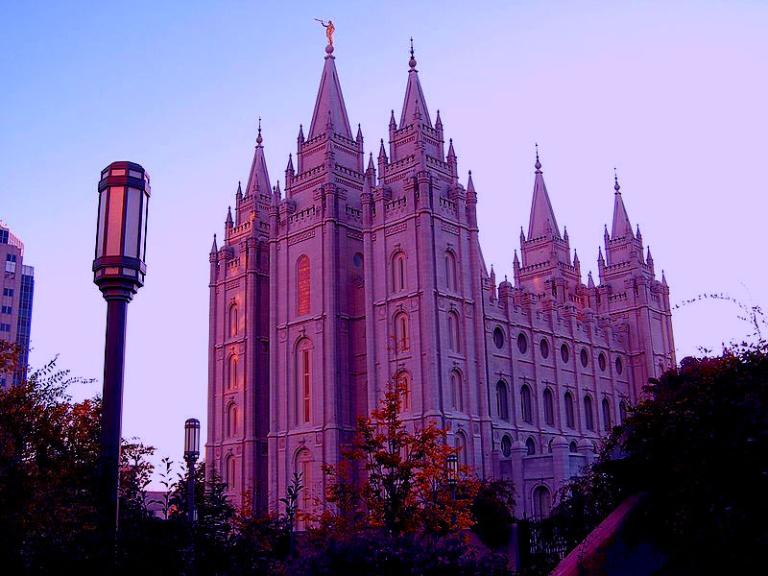
Michael
Many, including Elder Christofferson, have noted that the LDS Church’s new policy toward gay couples and their children is a carbon copy of the Church’s policy toward polygamous families, on the books since the 1920s. (If you’re curious, see Ardis Parshall’s post about it.) Most of these people have focused on how the Church is applying the old policy (re: polygamy) to a new situation (gay marriage).
But there’s another arrow of influence. The Church is turning the attitude toward gay marriage, which it has developed through decades of vehement, public, unequivocal opposition, toward polygamy, about which it has been mostly quiet save for condemnation of fundamentalists’ apostasy.
This is significant because polygyny lives on in LDS temple sealing protocol, vivified by the doctrine that unbreakable temple sealings bind families in heaven according to ordinances performed to create families on Earth. The 19th-century gender discrepancy continues unabated: living men can be sealed to multiple women at a time, living or dead; living women can only be sealed to one man at a time, living or dead. Indeed, Elders Dallin H. Oaks and Russell M. Nelson, second and third in line for the Church presidency, are both sealed to two women.
(Ironically, amid waves of overblown alarmism about the U.S. government forcing the Church to perform gay marriages in temple walls, we ourselves perform marriages in the temples that conflict with the Church’s publicly stated theology.)
Opposing gay marriage, however, has forced the Church to speak about marital forms with more clarity (if not theological sophistication). The constant political and rhetorical emphasis on “traditional marriage” has obligated Mormons to vigorously defend not only heterosexuality, but also monogamy, even if Mormons may deploy the spectre of legal polygamy somewhat less frequently in slippery-slope arguments than their Evangelical or Catholic comrades. Polygamy, once exalted as the peak of human sacral experience and for a long time hushed-up, yearned for, or despised, now finds Church authorities denigrating it.
Before Elder Christofferson’s interview about the new policy, the institutional church has made small but meaningful moves to discredit polygamy as a theologically acceptable concept, not merely excommunicating those who enter into multiple simultaneous earthly marriages in defiance of the law. One, on the Mormon Newsroom page, states that “The standard doctrine of the Church is monogamy, as it always has been, as indicated in the Book of Mormon” by the prophet Jacob. In my grandmother’s 1948 Book of Mormon, the chapter heading of Jacob 2 stated that the Lord rescinded the Nephites’ ability to practice polygamy because of their unrighteousness; from 1981 to 2013, it stated that Jacob condemned “unauthorized” polygamy; but now, it says that “the Lord commands that no man among the Nephites may have more than one wife”–no conditions or qualifications. The recent Gospel Topics essay on Mother in Heaven asserts that “just as we have a Father in Heaven, we have a Mother in Heaven”–relentlessly singular, no room for more than one mother, unlike nearly every other previous official statement on vague “heavenly parents.” Another of the essays says that “marriage between one man and one woman is God’s standard for marriage, unless He declares otherwise.” Polygamy was an “otherwise”–an exception that proves the rule.
So, Church leaders are
- associating opposition to polygamy with the unrelenting theological opposition to gay marriage,
- continually defending heterosexual monogamy in the public square, and
- changing scriptural metatexts to remove the vestiges of polygamy apologetics.
With this as evidence, here’s my theory:
While it opposes homosexual marriage more than instrumentally, the Church is taking the opportunity to prepare members for the seeming inevitability of legally recognized polygamy (which follows from the most popular arguments for gay marriage no matter what Jonathan Rauch musters to the contrary). By the time polygamy becomes accepted by the state and the population, LDS members will have had extensive experience and a greatly enlarged corpus of authoritative statements defending heterosexual monogamy as true marriage. Those who are most likely to believe in eternal polygamy–the more orthodox and, indeed, conservative who have often viewed monogamy as temporary compliance with the laws of the land–will have had years of experience exhorting proponents of same-sex marriage to follow the Brethren in matters of marital definition. The Brethren hope to fend off another polygamous schism and, perhaps, to put to final rest the largest, longest-lived thorn in the Church’s side.
Rachael
As Michael writes above, the Church’s discourse on polygamy and on gay marriage have become intertwined more tightly in recent events. While it’s very possible that the Church is utilizing the (blunt) instrument of policy change to pave the way for future resistance against the legalization of polygamy, to achieve this end there would certainly have to be further policy changes: chief among them, the immediate cessation of polygamous sealings among Church leadership.
As noted above, Elder Oaks and Elder Nelson are sealed to two women. Elder Oaks drew attention to this fact in a subtle way during a 2002 devotional address, when he mentioned the passing of his first wife, June, in the same sentence that he introduced Kristen McCain, “the eternal companion who now stands at my side.” Elder Nelson was sealed to Wendy L. Nelson within a year of his first wife, Dantzel Nelson, passing away. The searing irony of Elder Oaks and Elder Nelson, the Church’s current “sealed” polygamists, emerging as some of the Church’s most vocal defenders of “traditional marriage” and critics of gay marriage, has not been lost on some members.
That irony was thrown into relief again last week when the leaked handbook changes revealed that children of gay parents would be required to “disavow” the sexual and marital practices of their parents before baptism–apparently, in the same manner as children from polygamous families. I was unaware of this latter policy, and wondered– How can the Church require its members to denounce a practice that the leadership itself refuses to theologically disavow and, in fact, continues to practice in its highest echelons?
While the Church has long considered apostate those who practice polygamy with concurrently living spouses, the closest it has come to theologically disavowing the practice can be found in recent statements (on the LDS Newsroom and Gospel Essays) that “monogamy is the Lord’s standard” and that polygamy was an “exception” to the rule (reflected also in the recent editorial changes to epigraphs in Jacob 2 and the Manifestos in Doctrine and Covenants). While significant, the LDS Newsroom hedged in its Q&A on polygamy, responding to the query whether “polygamy [is] gone forever from the Church” with this: ”We only know what the Lord has revealed through His prophets, that plural marriage has been stopped in the Church. Anything else is speculative and unwarranted.”
I have had conversations with far, far too many women and men who continue to wonder (or weep, or rage) about the history and doctrine of polygamy and its future status. Unless the Church takes further steps to fully disavow its current practice and past doctrinal teachings on polygamy (a very thick corpus indeed), its current handbook changes may be even harder for some members to swallow, and the weight that the leadership is increasingly putting on the “traditional family” may become less and less sustainable.
This is in part because of the tension between the doctrine of “follow the prophet”– whether he says to practice polygamy, don’t practice polygamy, allow gay marriage, or don’t allow gay marriage– and the rhetoric of “traditional” marriage, as divinely rooted and unchanging. However, unless they disavow polygamy more thoroughly on a doctrinal basis rather than as a mandate “revealed through His prophets,” their stance on traditional marriage may appear as simply another prophetic mandate and thus something open to change. While that is always a possibility in the Mormon church, the handbook changes indicate even more clearly the leadership’s conviction that changes to gay marriage are not in the cards. But dealing with two decks–prophetic authority and unchanging, divine order– can be tricky business.
——
Note: I realize the conversation is and should be about the impact on gay members and prospective members in gay families, and I am in no way trying to detract from the pain these policy changes have caused. I do think the Church’s recent coupling of polygamy and gay marriage makes this particular issue, however, worth pointing out.










